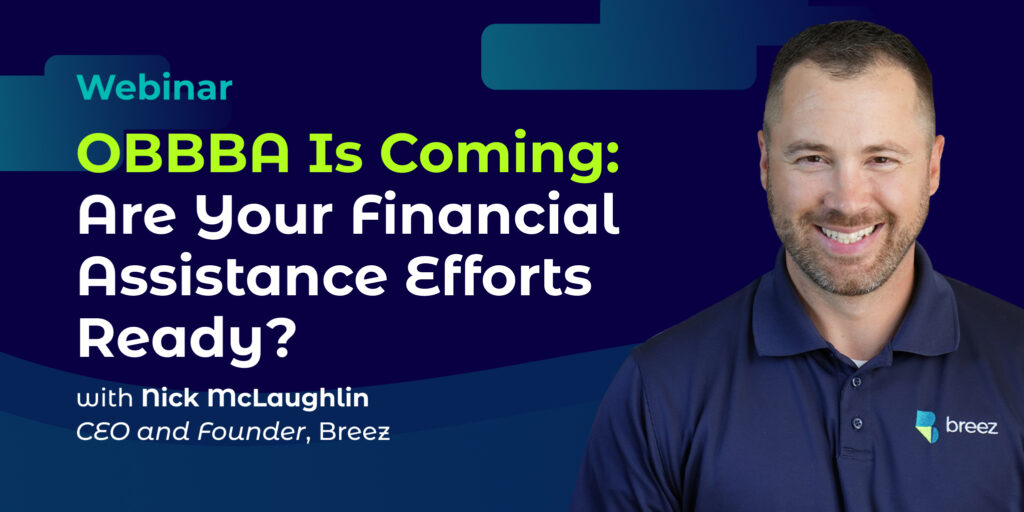The cover of most recent issue of The Journal of The American Association of Healthcare Administrative Management (AAHAM) features an article by Breez CEO Nick McLaughlin titled “The Covid-19 PHE Is Ending. Hospitals Need to Be Ready for Charity Care to Fill the Gaps.” Read the complete article below or view the magazine pages here.
After more than three years, the Covid-19 public health emergency (PHE) will end on May 11. As Medicaid standards and procedures return to normal, Health and Human Services estimates that 15 million patients will lose Medicaid coverage.
Of those 15 million losing coverage, 7 million are expected to still qualify for Medicaid and reenroll through the redetermination process, however, nearly all of the remaining 8 million patients will likely be eligible for hospital financial assistance programs. In order to prevent patients from falling into medical debt and hospitals from losing revenue, administrators need to iron out any kinks in their financial assistance enrollment processes and prepare for a very high volume of applications in 2023.
What has changed?
Since 2020, the only way someone would have been disenrolled from Medicaid is if they volunteered — which is rare. Normally, the state conducts redeterminations each year to establish Medicaid eligibility.
Under the PHE, however, these reviews were suspended. As a result, most of the people who were enrolled in Medicaid in early 2020 are likely still enrolled unless they obtained coverage elsewhere or came forward to update their income information.
Just before the Biden administration announced the end date of the PHE, Medicaid continuous enrollment was decoupled from the PHE and scheduled to end on March 31, 2023. In April, for the first time since 2020, beneficiaries can be disenrolled if they don’t meet the standard eligibility requirements or complete their redeterminations.
The Centers for Medicare and Medicaid Services has recommended states conduct this “unwinding process” over the course of a full year to ensure thorough redeterminations for every enrollee. Some states, especially those facing budget crunches, may move more quickly.
The burden on hospitals
Even in a normal year, Medicaid eligibility redetermination comes with a large amount of paperwork. Three years’ worth of redeterminations happening simultaneously is likely to create a backlog for the financial counseling staff at hospitals. Adding to the workload, most patients losing Medicaid coverage will be eligible for the hospital’s financial assistance program.
Patient engagement will be crucial
Engaging the patients who are dropped from Medicaid but who qualify for financial assistance is key to maintaining affordable access to care and ensuring hospitals get paid. When patients end up with bills they can’t pay, it contributes to medical debt — the leading cause of bankruptcy in the U.S. — and hurts the hospital’s bottom line, too.
From both a revenue and community perspective, offering discounted care to lower-income patients is better for the hospital than having those accounts wind up in bad debt.
To ensure these programs work as intended amid very high volume, hospital administrators will need to optimize their patient advocacy and financial counseling resources. Refining your financial assistance policy and application process are crucial because any existing headaches around it are about to multiply.
Fine-tuning financial assistance
Even at hospitals and health systems that fully comply with 501(r) requirements, many patients are still insufficiently informed about financial assistance programs, especially the fact that households with moderate incomes and health insurance can often qualify for discounts on care. Effectively promoting these programs to your patient population in a way that is proven to result in enrollment is key.
Promoting awareness in this year of transition will help prevent patients from falling through the cracks. However, the application and approval process must be efficient as well. Technology can help with this. By simplifying applications and moving them online, hospitals can prevent potential bottlenecks during this year’s onslaught of applications and financial counseling needs.
I used to work in collections and saw firsthand that patients who make up the majority of hospitals’ uncollectible bad debt belong to households that should qualify for financial assistance. While the end of the Covid-19 PHE could prove to be a bit of a rough transition, my hope is that hospitals will emerge from this period with highly effective financial assistance programs that support their revenue cycles and community for years to come.



